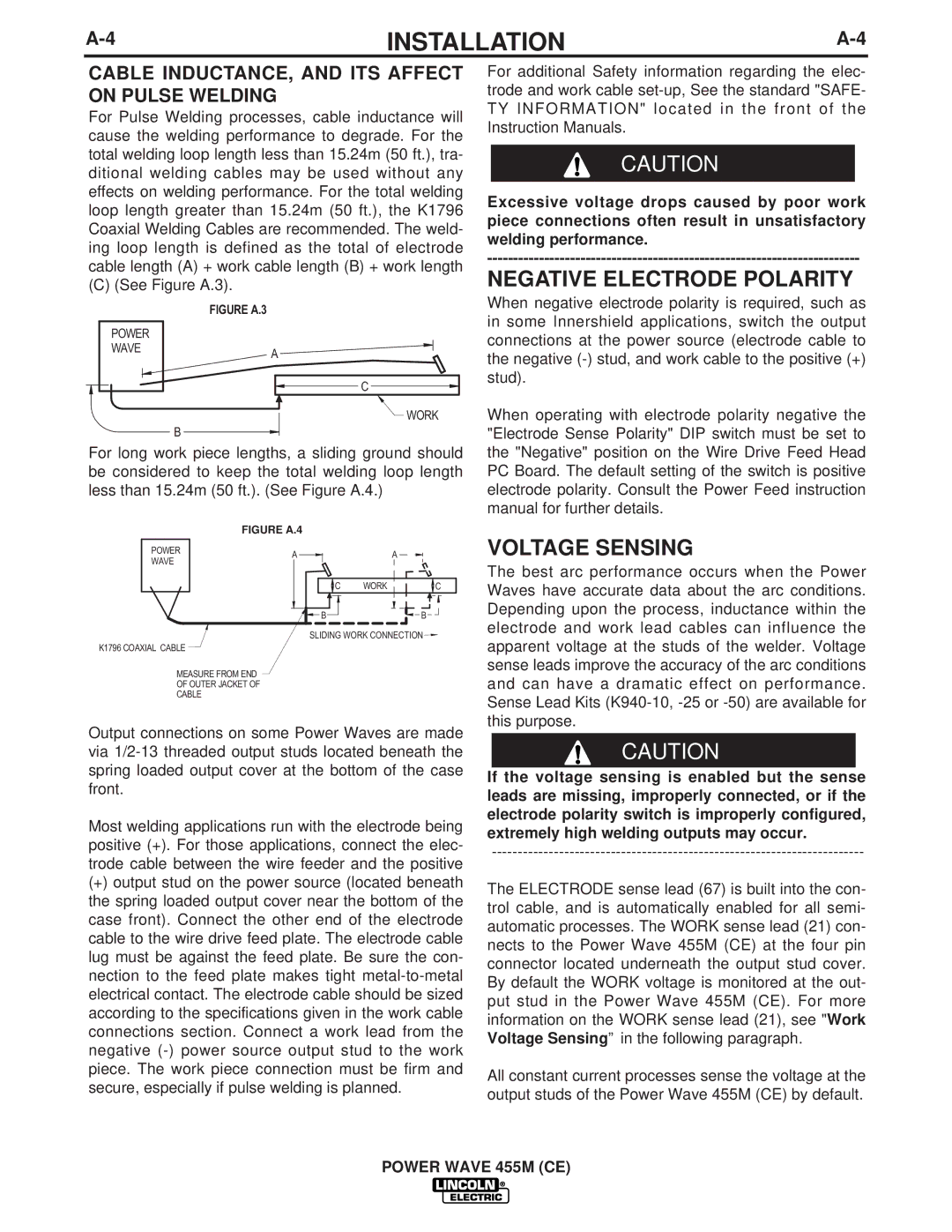
INSTALLATION | ||
|
|
|
CABLE INDUCTANCE, AND ITS AFFECT ON PULSE WELDING
For Pulse Welding processes, cable inductance will cause the welding performance to degrade. For the total welding loop length less than 15.24m (50 ft.), tra- ditional welding cables may be used without any effects on welding performance. For the total welding loop length greater than 15.24m (50 ft.), the K1796 Coaxial Welding Cables are recommended. The weld- ing loop length is defined as the total of electrode cable length (A) + work cable length (B) + work length
(C) (See Figure A.3).
| FIGURE A.3 |
POWER |
|
WAVE | A |
|
C |
WORK |
B
For long work piece lengths, a sliding ground should be considered to keep the total welding loop length less than 15.24m (50 ft.). (See Figure A.4.)
For additional Safety information regarding the elec- trode and work cable
CAUTION
Excessive voltage drops caused by poor work piece connections often result in unsatisfactory welding performance.
NEGATIVE ELECTRODE POLARITY
When negative electrode polarity is required, such as in some Innershield applications, switch the output connections at the power source (electrode cable to the negative
When operating with electrode polarity negative the "Electrode Sense Polarity" DIP switch must be set to the "Negative" position on the Wire Drive Feed Head PC Board. The default setting of the switch is positive electrode polarity. Consult the Power Feed instruction manual for further details.
POWER
WAVE
K1796 COAXIAL CABLE
FIGURE A.4
A |
| A |
C | WORK | C |
B | B |
SLIDING WORK CONNECTION | |
VOLTAGE SENSING
The best arc performance occurs when the Power Waves have accurate data about the arc conditions. Depending upon the process, inductance within the electrode and work lead cables can influence the apparent voltage at the studs of the welder. Voltage sense leads improve the accuracy of the arc conditions
MEASURE FROM END
OF OUTER JACKET OF
CABLE
Output connections on some Power Waves are made via
Most welding applications run with the electrode being positive (+). For those applications, connect the elec- trode cable between the wire feeder and the positive
(+)output stud on the power source (located beneath the spring loaded output cover near the bottom of the case front). Connect the other end of the electrode cable to the wire drive feed plate. The electrode cable lug must be against the feed plate. Be sure the con- nection to the feed plate makes tight
and can have a dramatic effect on performance. Sense Lead Kits
CAUTION
If the voltage sensing is enabled but the sense leads are missing, improperly connected, or if the electrode polarity switch is improperly configured, extremely high welding outputs may occur.
The ELECTRODE sense lead (67) is built into the con- trol cable, and is automatically enabled for all semi- automatic processes. The WORK sense lead (21) con- nects to the Power Wave 455M (CE) at the four pin connector located underneath the output stud cover. By default the WORK voltage is monitored at the out- put stud in the Power Wave 455M (CE). For more information on the WORK sense lead (21), see "Work Voltage Sensing” in the following paragraph.
All constant current processes sense the voltage at the output studs of the Power Wave 455M (CE) by default.
POWER WAVE 455M (CE)
